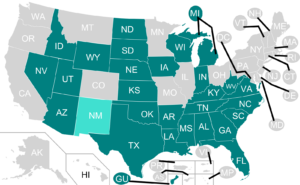
In 1947, the Taft-Hartley Act amended the National Labor Relations Act (NLRA) to allow states to enact right-to-work statutes. 28 states have since adopted those laws (state-wide laws are pictured above in green; blue holds local right-to-work laws), and union membership has been declining since. In the 1950s, 35 percent of the workforce held union memberships. That figure declined to 10.7 in 2017. Now the unions want to fight back by reversing decades of reform.
In 2018, two bills were introduced in Congress to roll back right-to-work laws: the Workplace Democracy Act and the Workers’ Freedom to Negotiate Act. The Workplace Democracy Act attempts to ban right-to-work laws, and the Workers’ Freedom to Negotiate Act would require nonunion employees to pay agency fees in right-to-work states.
Both bills are expected to be reintroduced in the new session of Congress. Read more about them here.

